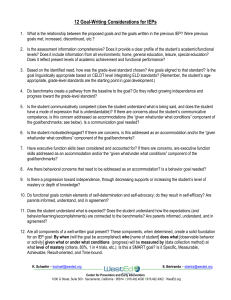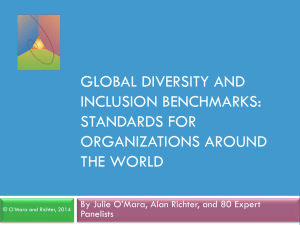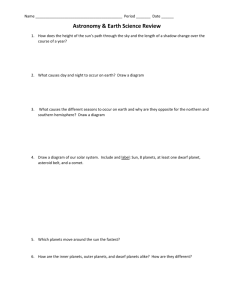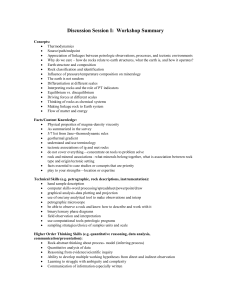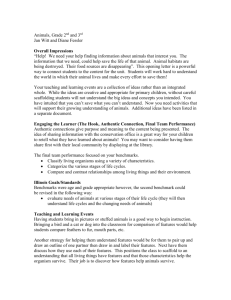Benchmarks to be taught in Accelerated Science 8
advertisement
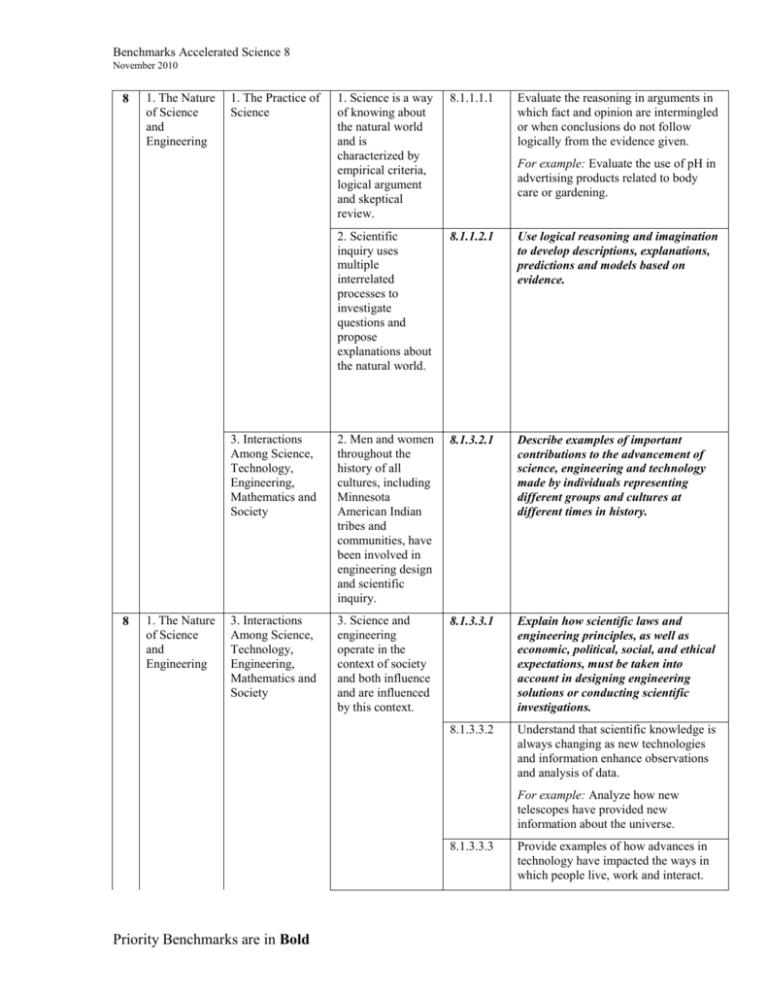
Benchmarks Accelerated Science 8 November 2010 8 8 1. The Nature of Science and Engineering 1. The Nature of Science and Engineering 1. The Practice of Science 1. Science is a way of knowing about the natural world and is characterized by empirical criteria, logical argument and skeptical review. 8.1.1.1.1 Evaluate the reasoning in arguments in which fact and opinion are intermingled or when conclusions do not follow logically from the evidence given. 2. Scientific inquiry uses multiple interrelated processes to investigate questions and propose explanations about the natural world. 8.1.1.2.1 Use logical reasoning and imagination to develop descriptions, explanations, predictions and models based on evidence. 3. Interactions Among Science, Technology, Engineering, Mathematics and Society 2. Men and women throughout the history of all cultures, including Minnesota American Indian tribes and communities, have been involved in engineering design and scientific inquiry. 8.1.3.2.1 Describe examples of important contributions to the advancement of science, engineering and technology made by individuals representing different groups and cultures at different times in history. 3. Interactions Among Science, Technology, Engineering, Mathematics and Society 3. Science and engineering operate in the context of society and both influence and are influenced by this context. 8.1.3.3.1 Explain how scientific laws and engineering principles, as well as economic, political, social, and ethical expectations, must be taken into account in designing engineering solutions or conducting scientific investigations. 8.1.3.3.2 Understand that scientific knowledge is always changing as new technologies and information enhance observations and analysis of data. For example: Evaluate the use of pH in advertising products related to body care or gardening. For example: Analyze how new telescopes have provided new information about the universe. 8.1.3.3.3 Priority Benchmarks are in Bold Provide examples of how advances in technology have impacted the ways in which people live, work and interact. Benchmarks Accelerated Science 8 November 2010 4. Current and emerging technologies have enabled humans to develop and use models to understand and communicate how natural and designed systems work and interact. 2. Physical Science 8 2. Physical Science 1. Matter 1. Matter Priority Benchmarks are in Bold 8.1.3.4.1 Use maps, satellite images and other data sets to describe patterns and make predictions about local and global systems in Earth science contexts. For example: Use data or satellite images to identify locations of earthquakes and volcanoes, ages of sea floor, ocean surface temperatures and ozone concentration in the stratosphere. 8.1.3.4.2 Determine and use appropriate safety procedures, tools, measurements, graphs and mathematical analyses to describe and investigate natural and designed systems in Earth and physical science contexts. 1. Pure substances can be identified by properties which are independent of the sample of the substance and the properties can be explained by a model of matter that is composed of small particles. 8.2.1.1.1 Distinguish between a mixture and a pure substance and use physical properties including color, solubility, density, melting point and boiling point to separate mixtures and identify pure substances. 8.2.1.1.2 Use physical properties to distinguish between metals and non-metals. 2. Substances can undergo physical and/or chemical changes which may change the properties of the substance but do not change the total mass in a closed system. 8.2.1.2.1 Identify evidence of chemical changes, including color change, generation of a gas, solid formation and temperature change. 8.2.1.2.2 Distinguish between chemical and physical changes in matter. 8.2.1.2.3 Use the particle model of matter to explain how mass is conserved during physical and chemical changes in a closed system. 8.2.1.2.4 Recognize that acids are compounds whose properties include a sour taste, characteristic color changes with litmus and other acid/base indicators, and the tendency to react with bases to produce a salt and water. Benchmarks Accelerated Science 8 November 2010 2. Physical Science 3. Energy 1. Waves involve the transfer of energy without the transfer of matter. 8.2.3.1.1 Explain how seismic waves transfer energy through the layers of the Earth and across its surface. 3. Earth and Space Science 1. Earth Structure and Processes 1. The movement of tectonic plates results from interactions among the lithosphere, mantle and core. 8.3.1.1.1 Recognize that the Earth is composed of layers, and describe the properties of the layers, including the lithosphere, mantle and core. 8.3.1.1.2 Correlate the distribution of ocean trenches, mid-ocean ridges and mountain ranges to volcanic and seismic activity. 8.3.1.1.3 Recognize that major geological events, such as earthquakes, volcanic eruptions and mountain building, result from the slow movement of tectonic plates. 8.3.1.2.1 Explain how landforms result from the processes of crustal deformation, volcanic eruptions, weathering, erosion and deposition of sediment. 8.3.1.2.2 Explain the role of weathering, erosion and glacial activity in shaping Minnesota's current landscape. 8.3.1.3.1 Interpret successive layers of sedimentary rocks and their fossils to infer relative ages of rock sequences, past geologic events, changes in environmental conditions, and the appearance and extinction of life forms. 8.3.1.3.2 Classify and identify rocks and minerals using characteristics including, but not limited to, density, hardness and streak for minerals; and texture and composition for rocks. 8.3.1.3.3 Relate rock composition and texture to physical conditions at the time of formation of igneous, sedimentary and metamorphic rock. 2. Landforms are the result of the combination of constructive and destructive processes. 8 3. Earth and Space Science 1. Earth Structure and Processes Priority Benchmarks are in Bold 3. Rocks and rock formations indicate evidence of the materials and conditions that produced them. Benchmarks Accelerated Science 8 November 2010 8 3. Earth and Space Science 2. Interdependence Within the Earth System 1. The sun is the principal external energy source for the Earth. 8.3.2.1.1 Explain how the combination of the Earth's tilted axis and revolution around the sun causes the progression of seasons. 3. The Universe 1. The Earth is the third planet from the sun in a system that includes the moon, the sun, seven other planets and their moons, and smaller objects. 8.3.3.1.1 Recognize that the sun is a mediumsized star, one of billions of stars in the Milky Way galaxy, and the closest star to Earth. 8.3.3.1.2 Describe how gravity and inertia keep most objects in the solar system in regular and predictable motion. Recognize that gravitational force exists between any two objects and describe how the masses of the objects and distance between them affect the force. 8.3.3.1.3 8.3.3.1.4 8.3.3.1.5 Priority Benchmarks are in Bold Compare and contrast the sizes, locations, and compositions of the planets and moons in our solar system. Use the predictable motions of the Earth around its own axis and around the sun, and of the moon around the Earth, to explain day length, the phases of the moon, and eclipses. Benchmarks Accelerated Science 8 November 2010 4. Human Interactions with Earth Systems 1. In order to maintain and improve their existence, humans interact with and influence Earth systems. 8.3.4.1.1 Describe how mineral and fossil fuel resources have formed over millions of years, and explain why these resources are finite and non-renewable over human time frames. 8.3.4.1.2 Recognize that land and water use practices can affect natural processes and that natural processes interfere and interact with human systems. For example: Levees change the natural flooding process of a river. Another example: Agricultural runoff influences natural systems far from the source. 9 10 2. Physical Science 11 12 2. Motion 9 10 2. Physical Science 11 12 Priority Benchmarks are in Bold 2. An object’s mass and the forces on it affect the motion of an object. 9.2.2.2.1 Recognize that inertia is the property of an object that causes it to resist changes in motion. 9.2.2.2.2 Explain and calculate the acceleration of an object subjected to a set of forces in one dimension (F=ma). 9.2.2.2.3 Demonstrate that whenever one object exerts force on another, a force equal in magnitude and opposite in direction is exerted by the second object back on the first object. 9.2.2.2.4 Use Newton’s universal law of gravitation to describe and calculate the attraction between massive objects based on the distance between them. For example: Calculate the weight of a person on different planets in the solar system. Benchmarks Accelerated Science 8 November 2010 3. Energy 2. Energy can be transformed within a system or transferred to other systems or the environment, but is always conserved. 9.2.3.2.1 Identify the energy forms and explain the transfers of energy involved in the operation of common devices. For example: Light bulbs, electric motors, automobiles or bicycles. 9.2.3.2.2 Calculate and explain the energy, work and power involved in energy transfers in a mechanical system. For example: Compare walking and running up or down steps. 9.2.3.2.3 Describe how energy is transferred through sound waves and how pitch and loudness are related to wave properties of frequency and amplitude. 9.2.3.2.4 Explain and calculate current, voltage and resistance, and describe energy transfers in simple electric circuits. 9.2.3.2.5 Describe how an electric current produces a magnetic force, and how this interaction is used in motors and electromagnets to produce mechanical energy. 9.2.3.2.6 Compare fission and fusion in terms of the reactants, the products and the conversion from matter into energy. For example: The fusion of hydrogen produces energy in the sun. Another example: The use of chain reactions in nuclear reactors. 9.2.3.2.7 Describe the properties and uses of forms of electromagnetic radiation from radio frequencies through gamma radiation. For example: Compare the energy of microwaves and X-rays. 9 10 2. Physical Science 4. Human Interaction with Physical Systems 11 12 Priority Benchmarks are in Bold 1. There are benefits, costs and risks to different means of generating and using energy. 9.2.4.1.1 Compare local and global environmental and economic advantages and disadvantages of generating electricity using various sources or energy. For example: Fossil fuels, nuclear fission, wind, sun or tidal energy. Benchmarks Accelerated Science 8 November 2010 9.2.4.1.2 Describe the trade-offs involved when technological developments impact the way we use energy, natural resources, or synthetic materials. For example: Fluorescent light bulbs use less energy than incandescent lights, but contain toxic mercury. 3. Earth and Space Science 1. Earth Structure and Processes 1. The relationships among earthquakes, mountains, volcanoes, fossil deposits, rock layers and ocean features provide evidence for the theory of plate tectonics. 9.3.1.1.1 Compare and contrast the interaction of tectonic plates at convergent and divergent boundaries. For example: Compare the kinds of magma that emerge at plate boundaries. 9.3.1.1.2 Use modern earthquake data to explain how seismic activity is evidence for the process of subduction. For example: Correlate data on distribution, depth and magnitude of earthquakes with subduction zones. 9.3.1.1.3 Describe how the pattern of magnetic reversals and rock ages on both sides of a mid-ocean ridge provides evidence of sea-floor spreading. 9.3.1.1.4 Explain how the rock record provides evidence for plate movement. For example: Similarities found in fossils, certain types of rocks, or patterns of rock layers in various locations. 9 10 3. Earth and Space Science 2. Interdependence Within the Earth System 11 12 Priority Benchmarks are in Bold 9.3.1.1.5 Describe how experimental and observational evidence led to the theory of plate tectonics. 3. By observing rock sequences and using fossils to correlate the sequences at various locations, geologic events can be inferred and geologic time can be estimated. 9.3.1.3.1 Use relative dating techniques to explain how the structures of the Earth and life on Earth have changed over short and long periods of time. 9.3.1.3.2 Cite evidence from the rock record for changes in the composition of the global atmosphere as life evolved on Earth. 1. The Earth system has internal and external sources of energy, which produce heat and drive the motion of material in the oceans, atmosphere and solid earth. 9.3.2.1.1 Compare and contrast the energy sources of the Earth, including the sun, the decay of radioactive isotopes and gravitational energy. (Also in Science 7 Pre AP/IB Prep) 9.3.2.1.2 Explain how the outward transfer of Earth’s internal heat drives the convection circulation in the mantle to move tectonic plates. For example: Banded iron formations as found in Minnesota's Iron Range. Benchmarks Accelerated Science 8 November 2010 3. The Universe 9 10 3. Earth and Space Science 4. Human Interactions with the Earth System 11 12 2. The solar system, sun, and Earth formed over billions of years. 3. The big bang theory states that the universe expanded from a hot, dense chaotic mass, after which chemical elements formed and clumped together to eventually form stars and galaxies. 1. People consider potential benefits, costs and risks to make decisions on how they interact with natural systems. 9.3.3.2.1 Describe how the solar system formed from a nebular cloud of dust and gas 4.6 billion years ago. 9.3.3.2.2. Explain how the Earth evolved into its present habitable form through interactions among the solid earth, the oceans, the atmosphere and organisms. 9.3.3.2.3. Compare and contrast the environmental conditions that make life possible on Earth with conditions found on the other planets and moons of our solar system. 9.3.3.3.1 Explain how evidence, including the Doppler shift of light from distant stars and cosmic background radiation, is used to understand the composition, early history and expansion of the universe. 9.3.3.3.2 Explain how gravitational clumping leads to nuclear fusion, producing energy and the chemical elements of a star. 9.3.4.1.1 Analyze the benefits, costs, risks and tradeoffs associated with natural hazards, including the selection of land use and engineering mitigation. For example: Determining land use in floodplains and areas prone to landslides. 9.3.4.1.2 Explain how human activity and natural processes are altering the hydrosphere, biosphere, lithosphere and atmosphere, including pollution, topography and climate. For example: Active volcanoes and the burning of fossil fuels contribute to the greenhouse effect. Priority Benchmarks are in Bold

